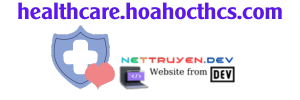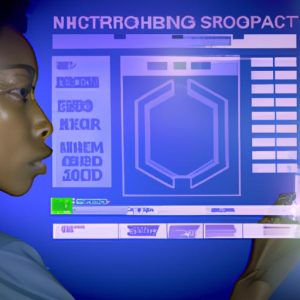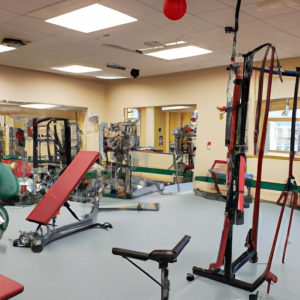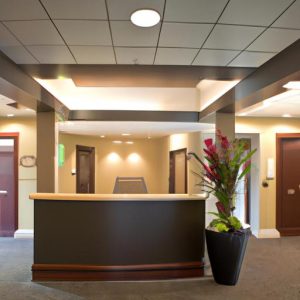The healthcare industry is continuously evolving, with advancements in technology playing a pivotal role in shaping its landscape. One such technological innovation that has gained significant traction is the Internet of Things (IoT) in healthcare. In this article, we will explore the definition and significance of IoT in revolutionizing healthcare as we know it.
A. Definition and Explanation of the Internet of Things (IoT) in Healthcare
The Internet of Things refers to the network of interconnected devices, sensors, and equipment that collect and exchange data seamlessly. In the context of healthcare, IoT enables the integration and communication of medical devices, wearables, and other healthcare-related gadgets. These interconnected devices work collaboratively to provide real-time monitoring, data analysis, and decision-making capabilities, ultimately enhancing patient care and improving healthcare outcomes.
B. Importance of IoT in Transforming the Healthcare Industry
IoT has emerged as a game-changer in healthcare, revolutionizing the way medical professionals deliver care and patients engage with their treatment. By harnessing IoT technology, healthcare providers can remotely monitor patients’ vital signs, enabling early detection of potential health issues and timely interventions. This enhanced patient monitoring not only improves the quality of care but also allows individuals to manage chronic conditions more effectively from the comfort of their homes.
Furthermore, IoT facilitates efficient healthcare operations by streamlining workflows and reducing human errors. With the integration of IoT devices, healthcare professionals can access accurate and real-time patient data, enabling quick decision-making and personalized treatment plans. This optimized resource management ensures the efficient allocation of healthcare resources, minimizing wastage and maximizing patient care.
In conclusion, the internet of things in healthcare has the potential to transform the future of medicine. With its ability to provide real-time monitoring, streamline operations, and improve patient outcomes, IoT is revolutionizing the healthcare industry. In the upcoming sections, we will delve deeper into the benefits, applications, challenges, and future trends of IoT in healthcare. Join me as we embark on an exciting journey, exploring the multitude of possibilities that IoT brings to the realm of healthcare.
Benefits of IoT in Healthcare

The integration of IoT in healthcare has brought forth numerous benefits that are transforming the way healthcare is delivered. Let’s explore the advantages that IoT offers in improving patient care and enhancing healthcare operations.
A. Improved Patient Monitoring and Remote Healthcare
1. Enhanced Patient Care through Real-time Monitoring
IoT enables healthcare providers to monitor patients in real-time, allowing for proactive and personalized care. By leveraging connected devices and wearables, vital signs, such as heart rate, blood pressure, and glucose levels, can be continuously tracked. This real-time monitoring empowers healthcare professionals to detect any abnormalities promptly, enabling timely interventions and minimizing the risk of complications. Patients can also actively participate in their own care by monitoring their health parameters and receiving personalized insights.
2. Remote Patient Monitoring for Chronic Conditions
IoT technology plays a vital role in managing chronic conditions by enabling remote patient monitoring. Patients with chronic ailments, such as diabetes, heart disease, or respiratory disorders, can use IoT-enabled devices to monitor their health status from the comfort of their homes. The data collected is transmitted securely to healthcare providers, who can remotely assess and analyze the information. This form of remote patient monitoring improves patient engagement, reduces hospital visits, and enhances overall disease management.
B. Efficient Healthcare Operations and Resource Management
1. Streamlined Workflow and Reduced Human Errors
IoT optimizes healthcare operations by streamlining workflows and minimizing human errors. With connected devices and sensors, healthcare professionals can access accurate and up-to-date patient information seamlessly. This eliminates the need for manual data entry and reduces the chances of errors caused by transcription or misplaced files. IoT also enables automated alerts and notifications, ensuring that healthcare providers are promptly informed of critical events or changes in patient conditions.
2. Optimized Resource Allocation and Inventory Management
Effective resource management is a crucial aspect of healthcare delivery, and IoT plays a vital role in optimizing resource allocation. By leveraging IoT devices and data analytics, healthcare facilities can track the usage of medical equipment, supplies, and medications in real-time. This enables efficient inventory management, preventing shortages or excesses, and ensuring that resources are readily available when needed. Additionally, IoT assists in predicting demand patterns, facilitating proactive procurement and reducing wastage.
In the next section, we will explore the diverse applications of IoT in healthcare, ranging from wearable devices to telemedicine. Stay tuned to discover the exciting possibilities that IoT brings to the world of healthcare.
Applications of IoT in Healthcare
As the Internet of Things (IoT) continues to permeate various sectors, its impact on healthcare is undeniable. IoT applications in healthcare have the potential to revolutionize patient care, improve diagnostics, and enhance overall health outcomes. Let’s explore some of the key applications of IoT in healthcare:
A. Wearable Devices and Health Trackers
Wearable devices and health trackers have become increasingly popular in recent years, and for good reason. These devices, such as smartwatches and fitness bands, are equipped with sensors that monitor vital signs and activity levels in real-time. By collecting data on heart rate, blood pressure, sleep patterns, and more, wearable devices empower individuals to take control of their health and make informed decisions.
-
Monitoring Vital Signs and Activity Levels: Wearable devices continuously track and record vital signs, providing individuals with valuable insights into their overall well-being. Whether it’s monitoring heart rate during exercise or tracking sleep patterns, these devices offer personalized data that can be used to improve health and wellness.
-
Early Detection of Health Issues and Preventive Care: Wearables equipped with advanced algorithms can detect anomalies in vital signs and activity patterns. By identifying potential health issues early on, individuals can seek appropriate medical attention and take preventive measures to manage their health effectively.
B. Smart Medical Equipment and Devices
IoT has facilitated the integration of smart medical equipment and devices, transforming the way healthcare professionals operate and patients receive care.
-
Integration of Medical Devices for Seamless Data Sharing: IoT enables the seamless integration of medical devices, allowing for the automatic and secure exchange of patient data. This integration eliminates manual data entry, reduces errors, and ensures healthcare providers have access to up-to-date information for accurate diagnoses and treatment decisions.
-
Automated Alerts and Notifications for Timely Interventions: Smart medical devices can be programmed to send automated alerts and notifications to healthcare providers in case of critical changes in a patient’s condition. This timely intervention can prevent adverse events, improve patient safety, and save lives.
C. Telemedicine and Remote Consultations
Telemedicine, powered by IoT, has emerged as a game-changer in healthcare, particularly in remote areas and during times of crisis.
-
Facilitating Virtual Doctor-Patient Interactions: IoT enables virtual doctor-patient interactions through video conferencing, enabling individuals to consult healthcare professionals from the comfort of their homes. This convenience eliminates the need for physical visits, reduces waiting times, and improves access to healthcare services.
-
Remote Diagnostics and Consultations for Rural Areas: IoT allows for remote diagnostics, with medical devices collecting patient data and transmitting it securely to healthcare providers. This capability is particularly beneficial for individuals residing in rural areas with limited access to healthcare facilities, enabling them to receive expert medical advice without the need for travel.
In the next sections, we will delve into the challenges and risks associated with IoT in healthcare, as well as explore future trends and innovations that hold immense potential for the industry. Stay tuned as we continue to unravel the fascinating realm of IoT in healthcare.
Challenges and Risks of IoT in Healthcare
The integration of IoT in healthcare brings forth a multitude of benefits, but it also presents certain challenges and risks that need to be addressed. In this section, we will explore the key challenges associated with IoT in healthcare and discuss potential solutions.
A. Data Security and Privacy Concerns
As healthcare becomes increasingly digitized, the security and privacy of patient data emerge as critical concerns. With the vast amount of sensitive information being transmitted and stored by IoT devices, ensuring robust data security is paramount.
1. Protecting Sensitive Patient Information from Cyber Threats
The interconnected nature of IoT devices creates potential vulnerabilities that malicious actors can exploit. Healthcare organizations must implement robust cybersecurity measures to safeguard patient data from unauthorized access or data breaches. This includes encryption techniques, strong access controls, and regular security audits to identify and address any potential vulnerabilities.
2. Ensuring Compliance with Data Protection Regulations
With the growing concerns surrounding data privacy, healthcare providers must adhere to stringent data protection regulations such as the Health Insurance Portability and Accountability Act (HIPAA) in the United States. Compliance with these regulations is essential to protect patient privacy and maintain trust in the healthcare system. Organizations need to establish comprehensive data governance policies and procedures to ensure compliance and mitigate risks.
B. Interoperability and Standardization Issues
Another challenge presented by IoT in healthcare is the interoperability and standardization of devices and data exchange protocols. The vast array of IoT devices and platforms often operate on different communication protocols, making it difficult to integrate them seamlessly into existing healthcare systems.
1. Integrating Various IoT Devices and Platforms
To fully leverage the potential of IoT in healthcare, it is crucial to establish interoperability between different devices and platforms. This requires the development of common communication standards and protocols that enable seamless data exchange. Industry collaborations and standardization bodies play a vital role in driving the adoption of common interoperability standards.
2. Establishing Common Standards for Data Exchange
In addition to device interoperability, the exchange of data between different healthcare systems and stakeholders needs to follow standardized protocols. This ensures that data can be shared seamlessly, enabling efficient collaboration and informed decision-making. Implementing standardized data exchange protocols and fostering data-sharing agreements among healthcare providers are essential steps to overcome this challenge.
In conclusion, while IoT brings numerous benefits to healthcare, it also introduces challenges and risks. Addressing data security and privacy concerns, as well as promoting device interoperability and standardization, are crucial for the successful integration of IoT in healthcare. By acknowledging these challenges and working towards viable solutions, we can unlock the full potential of IoT and revolutionize the healthcare industry.
Future Trends and Innovations in IoT Healthcare
The future of healthcare is brimming with exciting possibilities as the Internet of Things (IoT) continues to advance. In this section, we will explore two key trends that are set to reshape healthcare through IoT integration: Artificial Intelligence (AI) and Machine Learning (ML) integration, and the utilization of Blockchain technology for secure healthcare data management.
A. Artificial Intelligence (AI) and Machine Learning (ML) Integration
The integration of AI and ML technologies with IoT in healthcare holds immense potential for transforming data analysis and predictive healthcare. By leveraging AI and ML algorithms, healthcare systems can analyze vast amounts of patient data collected through IoT devices. This analysis enables healthcare providers to identify patterns, detect anomalies, and make accurate predictions regarding patient health outcomes.
-
Enhancing Data Analysis and Predictive Healthcare
AI and ML algorithms can process and analyze patient data in real-time, extracting actionable insights. By monitoring vital signs, medication adherence, and lifestyle patterns, IoT devices generate a wealth of data that, when combined with AI and ML, can offer valuable predictive analytics. These insights enable early identification of potential health issues, allowing for proactive interventions and personalized treatment plans. -
Personalized Medicine and Treatment Recommendations
The integration of IoT, AI, and ML enables the delivery of personalized medicine and treatment recommendations. By considering an individual’s unique health data, including genetics, medical history, and lifestyle choices, AI algorithms can generate tailored treatment plans. This personalized approach ensures improved patient outcomes, reduced trial and error, and enhanced patient satisfaction.
B. Blockchain Technology for Secure Healthcare Data Management
Blockchain technology, renowned for its decentralized and transparent nature, offers a secure solution for healthcare data management. By leveraging blockchain within IoT healthcare systems, sensitive patient information can be securely stored, shared, and accessed, while maintaining data integrity and patient privacy.
-
Immutable and Transparent Patient Records
Blockchain technology ensures the immutability and transparency of patient records. Each transaction or update is encrypted, time-stamped, and added to a chain of blocks, creating a permanent and unalterable record. This decentralized approach enhances data security, minimizes the risk of data breaches, and provides a trustworthy source of truth for healthcare providers. -
Streamlined Healthcare Transactions and Supply Chain Management
Blockchain facilitates streamlined healthcare transactions and supply chain management by eliminating intermediaries and automating processes. Smart contracts, powered by blockchain, enable secure and automated verification, execution, and validation of healthcare transactions. This leads to improved efficiency, reduced administrative burdens, and enhanced traceability within the healthcare ecosystem.
In conclusion, the integration of AI, ML, and blockchain technologies with IoT in healthcare represents a promising future. These innovations have the potential to revolutionize data analysis, predictive healthcare, personalized medicine, and secure healthcare data management. As we move forward, it is crucial for healthcare organizations to embrace these trends and harness the power of IoT to unlock a new era of healthcare excellence.
Conclusion
The Internet of Things (IoT) has emerged as a transformative force in the healthcare industry, revolutionizing the way we deliver and receive medical care. Throughout this article, we have explored the definition, benefits, applications, challenges, and future trends of IoT in healthcare. The potential of IoT to improve patient monitoring, streamline operations, and enhance healthcare outcomes is undeniable.
As we have seen, IoT enables remote patient monitoring, allowing healthcare professionals to gather real-time data and provide timely interventions. This not only improves patient care but also empowers individuals to actively participate in their own well-being. Wearable devices and health trackers have become essential tools in managing chronic conditions and promoting preventive care.
IoT also optimizes healthcare operations by streamlining workflows and reducing human errors. The integration of smart medical equipment and devices enables seamless data sharing, automated alerts, and notifications, ensuring efficient resource allocation and inventory management. Telemedicine and remote consultations have bridged the gap between doctors and patients, providing access to quality healthcare in remote areas.
However, it is crucial to address the challenges and risks associated with IoT in healthcare. Data security and privacy concerns must be addressed to protect sensitive patient information from cyber threats. Ensuring interoperability and standardization across various IoT devices and platforms is essential for seamless integration and data exchange.
Looking ahead, the future of IoT in healthcare is promising. The integration of Artificial Intelligence (AI) and Machine Learning (ML) will enhance data analysis, predictive healthcare, and personalized medicine. Blockchain technology will provide secure and transparent healthcare data management, revolutionizing patient records and streamlining healthcare transactions.
In conclusion, the Internet of Things in healthcare has the potential to transform the way we receive and deliver medical care. With its ability to improve patient monitoring, optimize operations, and drive innovation, IoT is set to revolutionize the healthcare industry. Let’s embrace this technological revolution and leverage the power of IoT to create a healthier and more connected world.



